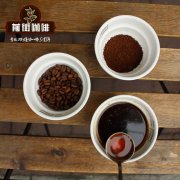What is the variety of Castillo Castillo? Colombia cultivates coffee varieties.

The variety of Castillo (Castillo) coffee is controversial. On the one hand, it can resist leaf rust. Coffee professionals, on the other hand, are wary of the fact that their parents include Robusta and Arabica hybrids.
Leaf rust resistant varieties
Coffee leaf rust, or la roya in Spanish, is one of the biggest threats to farmers' crops. The disease affects the leaves of coffee plants and appears in the form of orange spots. Because leaves are the place where photosynthesis takes place, when the leaves rust, the plant's ability to generate energy decreases. In the worst case, the leaves fall from the tree and no coffee cherries can be produced.
Caffeine rust was prevalent in Central America in 2012, and the region is still recovering. Then, this spring, it was reported that Lempira, previously thought to protect against leaf rust, had been infected with rust in Honduras.
These developments have intensified the discussion about leaf rust-resistant coffee varieties, but this is not a new topic. Coffee leaf rust has been a problem for more than a century (although it was not confirmed in all major coffee producing countries until 1990). For decades, research centers around the world have been working to produce rust-resistant coffee plants.
The challenge is to create an antirust variety with a good cup shape.
The Cenicaf é Research Centre of Colombian Coffee is dedicated to studying and improving all aspects related to coffee cultivation. In 1968, it began a genetic improvement program to develop rust-resistant varieties.
Hernando told me that the center first looked at the hybrid between Kaddura and Timor. In this way, a rust-proof variety was developed and marked as Catimors (Katim). Kaddura is small and compact, allowing producers to grow more plants in the same area. On the other hand, Timo is the Arabica-Robusta cross of East Timor with excellent rust resistance.
The original experiment was the Colombian variety. Hernando told me that it was released in 1982, a year before leaf rust first arrived in the country.
But he explained that Cenicaf é wanted to further improve the variety. The goal is to increase productivity, improve resistance, increase beans, and improve quality, similar to Kaddura. Most importantly, tenacity is important in view of the long life of coffee plants.
After more experiments, the team finally succeeded. Cenicaf é created five generations of Castillo, which was put into production in 2005 after 23 years of research and development.
It is common for rust-tolerant varieties to lose their tolerance over time. Similarly, no coffee variety can resist every kind of leaf rust.
However, after 12 years, Castillo is still resistant to both leaf rust and coffee fruit disease. "We want [resistance] to remain for more than 15 years, which will give us time to create new varieties," Hernando told me. "
Castillo introduction
Castillo (Castillo) is famous for its smoothness, aroma and citric acid. Gloria told me that through blind tests and other sensory evaluations, Columbia Cafe found that it could have qualities similar to those of Iron pickup, Kaddura and Bourbon.
Cenicaf é succeeded in bringing Kaddura's short stature and relatively high production to Castillo, making it an ideal choice for producers. But not all Castillo are the same: Cenicaf é has created six different forms of Castillo designed to meet the climatic conditions of six different regions.
This diversity will help Castillo maintain its anti-rust performance. "We need to maintain different expectations and preparations for the development of the disease," Hernando said. " He also told me that the more uniform the coffee crop, the greater the risk of spreading the disease.
Castillo VS Kaddura
Hernando and Gloria know that some specialty coffee buyers think the quality of Castillo is lower than that of other varieties. But they told me that because it required fewer fungicides, it contributed to the sustainability of the Colombian coffee industry. All these will damage the environment and increase the production cost of farmers.
In addition, there is some evidence that Castillo (Castillo) can produce high-quality professional coffee.
In 2014, the International Center for Tropical Agriculture (CIAT) in Colombia, the World Coffee Research (WCR), the Center for sensory Analysis at Kansas State University (KSU) and several cup makers collaborated to form the Colombian sensory experiment. Between 2014 and 2015, they conducted comparative sensory analyses of Castillo and Kaddura. All the coffee analyzed were grown on the same farm and treated in the same way.
Result? Although the flavor characteristics vary greatly, the cups of the two varieties have similar scores. The cup degree of some Castillo samples is 90 +.
Moreover, the advice to producers is that varieties may not be as important as the environment and farm management. Soil fertility, shadow management, harvesting and processing practices-these are things related to cups, not varieties.
Gloria explained that ensuring the quality of the final cup is a comprehensive process. "it depends not only on the variety, although it brings some sensory quality, but also on the processing method, drying, picking and farm height."
Pre-emptive measures mean that Colombia already had varieties resistant to leaf rust before the onset of the disease in the 1980s. Cenicaf é believes this is crucial.
Coffee berry disease is mainly found in Africa and has not yet occurred in Colombia. But Hernando says it is important for Castillo é to make sure that Cenicafe (Castillo) is resistant to it.
Coffee growers face more challenges. Higher temperatures hinder Arabica coffee, reduce its yield and make it more sensitive to coffee pests.
Hernando mentioned the importance of preparing for damage caused by biological (living things in the ecosystem, such as insects) and abiotic (abiotic parts of the ecosystem: sunlight, temperature, gases in the atmosphere, water and soil). Drought, soil acidity, pests-they all limit coffee production.
"We are currently working on developing new varieties to deal with these problems," he said. "
More importantly, Cenicaf é knows that leaf rust will always be a threat and will continue to grow. "one preventive way to solve this problem is to incorporate new genes that may produce new resistance in the variety," Hernando continued.
Before creating these new varieties, Castillo can provide producers and buyers with the potential for corrosion resistance, high yield and high cup score.
Important Notice :
前街咖啡 FrontStreet Coffee has moved to new addredd:
FrontStreet Coffee Address: 315,Donghua East Road,GuangZhou
Tel:020 38364473
- Prev

What are the characteristics of Cenicaf é 1, a new coffee variety cultivated in Colombia?
The selection of coffee varieties will affect the taste, growth conditions, roasting characteristics of coffee, etc., which makes the release of the new Colombian variety Cenicaf1 exciting. Agronomist Claudia Flores (Claudia Florez), PhD in plant breeding, works with the Colombian Coffee Growers Federation (FNC) and its research center Cenicaf. She well agreed to talk to me about the new
- Next

Coffee varieties | the rise of hybrid coffee varieties what kind of coffee is F1?
Before introducing mixed coffee, let's briefly introduce the types and types of coffee. There are 125 kinds of coffee. But almost all coffee served in coffee shops or sold in supermarkets is Arabica coffee, robusta coffee or a mixture of both. Arabica coffee is the most common species, famous for its high-quality flavor and aroma, but it is also the most susceptible
Related
- Detailed explanation of Jadeite planting Land in Panamanian Jadeite Manor introduction to the grading system of Jadeite competitive bidding, Red bid, Green bid and Rose Summer
- Story of Coffee planting in Brenka region of Costa Rica Stonehenge Manor anaerobic heavy honey treatment of flavor mouth
- What's on the barrel of Blue Mountain Coffee beans?
- Can American coffee also pull flowers? How to use hot American style to pull out a good-looking pattern?
- Can you make a cold extract with coffee beans? What is the right proportion for cold-extracted coffee formula?
- Indonesian PWN Gold Mandrine Coffee Origin Features Flavor How to Chong? Mandolin coffee is American.
- A brief introduction to the flavor characteristics of Brazilian yellow bourbon coffee beans
- What is the effect of different water quality on the flavor of cold-extracted coffee? What kind of water is best for brewing coffee?
- Why do you think of Rose Summer whenever you mention Panamanian coffee?
- Introduction to the characteristics of authentic blue mountain coffee bean producing areas? What is the CIB Coffee Authority in Jamaica?

